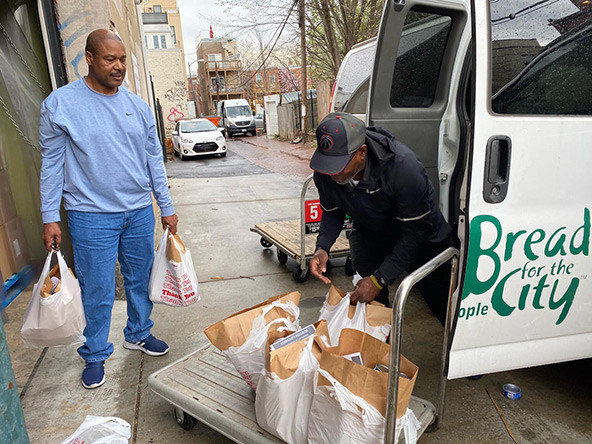 Since its food pantries have closed, the nonprofit Bread for the City has worked with partners to deliver groceries in Washington, DC. (Photo courtesy of Bread for the City)
Since its food pantries have closed, the nonprofit Bread for the City has worked with partners to deliver groceries in Washington, DC. (Photo courtesy of Bread for the City)
Nonprofit sustainability, or the ability to continue delivering relevant social impact over the long term, has always been important to nonprofit leaders. But as the spread of COVID-19 causes upheaval in just about every aspect of society and highlights the deep social inequities many nonprofits are working to address, sustainability is becoming even more of a top priority. Over the past few weeks, we’ve spoken with many nonprofit leaders who are worrying about how they will continue to sustain the important programs and services their organizations deliver. Indeed, a recent survey from LaPiana Consulting found that 93 percent of nonprofit respondents have already had to adapt or curtail services.
Naturally, financial health is crucial to ensuring that organizations can continue their work in the months and years ahead. However, our research looking at more than 50 nonprofits after the 2008 economic downturn and the years that followed (one example here), as well as our direct experience working with hundreds of nonprofits, shows the need to take a broader view. Before doubling down on financial health and organizational preservation, nonprofits should first reflect on their social purpose. Getting clear on the impact they want to have will then help guide decisions about how to financially sustain the work and how to build the capacities needed to deliver impact. Here are three areas nonprofits should be looking at now.

Social Impact: Why Do You Do What You Do?
First and foremost, make time to revisit your vision for social impact—the impact you’re trying to create and how you plan to create it—as context and needs change. In addition to informing decisions on finances and capacity, this helps ensure that your work remains relevant. Many of the organizations we’ve talked to are shifting the way they deliver programs and services, forging new partnerships to extend their reach and impact, or using this moment to advocate for systemic change. One example is the nonprofit Bread for the City, which provides food, medical, legal, and social services in Washington, DC. After having to close their food pantries to the public, the organization began working with new partners to get groceries to constituents, and expanded its medical services to include telehealth and COVID-19 testing.
Another important consideration is how you frame the value of your work in the current context—why your mission matters now—to rally donors, engage partners, and motivate staff. For example, although social distancing guidelines have disrupted the nonprofit KaBOOM!’s main programmatic offering of working with communities to build playspaces, the organization knows that playspaces will be important during the recovery from the COVID-19 crisis. Through partnerships in regions recovering from hurricanes and other emergencies, KaBOOM! has seen how its model brings communities together and creates a vital offering for kids. In a recent blog post, CEO James Siegal writes, “If anything, this crisis demonstrates how valuable playgrounds are as community gathering places. As with many other issues, this crisis also highlights, and will likely exacerbate, the disparities that already exist in access to quality places to play.” KaBOOM! is now engaging constituents in new ways, such as hosting virtual design days with communities that provide a space for playground design experts (kids) to draw their dream playgrounds.
Economic Viability: How Do You Fund What You Do?
Nonprofits need to be financially viable to deliver impact. Sustainable organizations have predictable and reliable revenue, expenses that line up with expected revenue, sufficient cash on hand to cover routine and emergency needs, and processes in place to monitor finances and plan for contingencies. (For more guidance on this, see Nonprofit Finance Fund’s Financial Self-Assessment Worksheet.)
Many nonprofits are currently facing an increase in demand for services, coupled with significant disruptions to their funding streams. A recent survey from Nonprofit Finance Fund found that most nonprofits (60 percent) are experiencing destabilizing conditions that threaten their long-term financial stability, and even more (64 percent) expect to experience continued threats in the months ahead.
Despite this destabilization and uncertainty, there are some things leaders can do right now:
- Assess your current situation. Right now, cash management is critical. What are your monthly operating costs? How much cash do you have on hand? Look at the diversification of your donors. While now may not be the time to pursue new streams of funding, it’s important to understand your reliance on various revenue streams and individual donors so that you know how to respond if a major funding source goes away.
- Create financial scenario plans. No one knows what the future holds for our economy or how it will affect their organizations. Create a best, a worst, and an expected case scenario with clear plans for how you’ll respond to each one if it happens. Use external data and prior experience to try to make a reasonable set of assumptions and focus on the things you can control to put your organization in the best possible position. In some scenarios, sustaining impact over the long term may mean scaling back in the short term or even merging, as many nonprofits had to do after the 2008 recession. (Nonprofit Finance Fund has created a free scenario planning template organizations can use, including a video on how to use it.)
- Have honest conversations with your donors and stakeholders. Make sure your donors understand your needs. Ask them direct questions about their plans and intentions so that you can get some sense of the reliability of your contributed revenue streams. Similarly, to help gauge the predictability of earned revenue streams (such as fees for services, ticket sales, or memberships), consider talking to customers and/or members to better understand whether and how they plan to engage with your organization in the months ahead. Many organizations are finding success in asking customers or members to donate pre-paid fees for canceled services and events to help programs and services they care about continue in the future.
Capacity to Deliver: What Supports What You Do?
Delivering social impact requires talent, systems, and processes. In response to stay-at-home orders across the world, organizations have had to shift to virtual operations, make up for lost volunteers, and deal with other challenges to capacity. Planned Parenthood of Metropolitan Washington, for example, had to move fast to establish technology and infrastructure so that it could launch telehealth services to patients months earlier than originally planned. Meanwhile Share Our Strength (our parent organization) has experienced a dramatic decrease in earned revenue from events and a dramatic increase in giving from individual donors, and therefore shifted its team’s capacity to focus on fundraising.
While different organizations have different capacity needs, these four are core to sustainability:
- Leadership capacity. Organizations that remain resilient during challenging times tend to have strong and diffuse leadership that can make quick decisions in response to evolving challenges. Prioritizing a well-functioning executive team, frequent and transparent communications with staff, and good governance practices all help build and maintain the kind of trust a productive culture requires. This moment also demands that leadership recognize the full humanity of staff members, and model authenticity and vulnerability. “We’ve had to up our game in matters of the heart, and give people permission, through our words and deeds, to display their pain,” Maurice Jones, CEO of LISC, told us. At a recent, virtual staff meeting, Jones reflected on what religious holidays might mean to people during this time. Leaders who embrace authenticity now will also be better positioned to recruit, retain, and support their talent over the long-term. (Read more on leading during COVID-19 here.)
- Adaptive capacity. The importance of adaptability right now is apparent. Consider possible changes in client needs, behaviors, and the operating environment over the next six-12 months, and how your organization could respond. Set short-term financial and impact goals, along with plans for what you’ll do if you don’t meet them. As you consider creative new approaches or solutions, think about experimenting with rapid prototyping approaches, rather than launching major initiatives that require extensive analysis and proven track records.
- Collaborative capacity. Many organizations are coming together in creative ways to boost social impact during this time. The Alliance to End Hunger, for example, recently convened a group of national, anti-hunger organizations to coordinate food assistance efforts. Through daily phone calls, the group coordinated an advocacy campaign to bolster the Supplemental Nutrition Assistance Program (SNAP) in both the Families First Coronavirus Response Act and the CARES Act, and continues to advocate for a boost to SNAP benefits. But partnering effectively requires certain capacities. Human resources strategist Pratichi Shah recommends focusing on how collaboration shows up in three organizational pillars: 1) a culture that explicitly calls out the importance of collaboration, 2) a team with collaborative skillsets, and 3) leadership that models and incentivizes collaborative behaviors.
- Technology capacity. A recent Salesforce survey found that 85 percent of nonprofits say technology is important to their long-term success, yet only 23 percent have a long-term strategy or vision for how they will use technology. As nonprofits have scrambled to shift to virtual operations, the need for strong systems and staff who can use them has become even more clear. Technology capacity is critical to business continuity now and will remain critical during recovery—both for data-informed decision-making, and as a method of delivering services at lower cost and greater scale.
A Call to Action for Funders
As others have written, long-standing, white-dominant practices and a charity mindset in philanthropy have created deep inequities in terms of who receives funding and how. These inequities make it particularly hard for the organizations and movements closest to marginalized communities—often grassroots organizations led by people of color—to build the financial reserves and capacities that can help during times of crisis. As we watch the spread of COVID-19 disproportionately impact communities of color, funders must invest in movements and organizations that serve these communities so that they can continue their important work, change course where needed, and ultimately recover. This moment calls for a new way forward for philanthropy—one that prioritizes dismantling oppressive systems, redistributing resources, and amplifying power for the people closest to the problems the sector seeks to solve.
Staying True to Purpose
The volatility and uncertainty of the past few weeks has left many nonprofit leaders feeling like they’re in a tailspin. Our advice is to apply the same mindset to your organization that you are likely applying to your personal life. Just as this crisis has caused many of us to refocus on the things that matter most to us personally, use this time as an opportunity to bring that same focus to your organization. Reground yourself in why your organization does what it does, and use that as your north star to help determine what you need to support that vision, both financially and in terms of organizational capacity.
Support SSIR’s coverage of cross-sector solutions to global challenges.
Help us further the reach of innovative ideas. Donate today.
Read more stories by Amy Celep, Megan Coolidge & Lori Bartczak.

